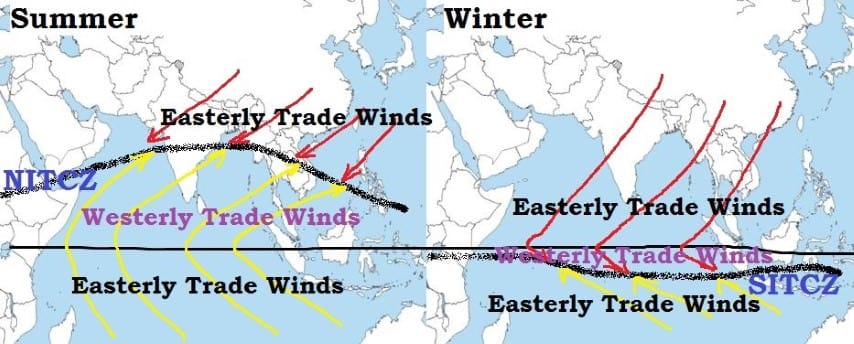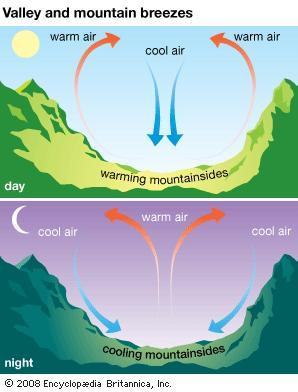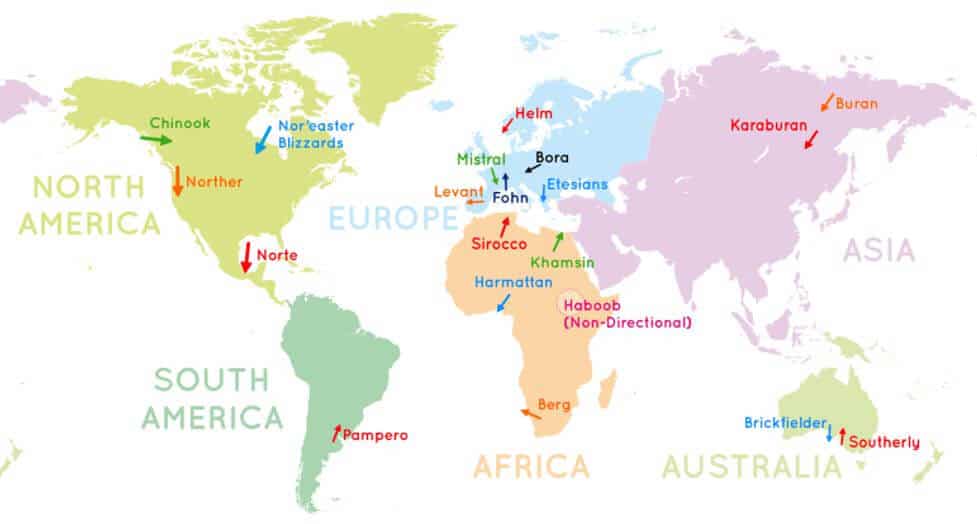The wind in simple terms is the horizontal movement of Air. This horizontal movement is caused by differences in air pressure within our atmosphere. Wind under high pressure moves toward areas of low pressure. In this article, we will learn about the Types Of Wind.

Types of Wind

Permanent winds or Primary winds or Prevailing winds or Planetary Winds
- The trade winds, westerlies and easterlies.
Secondary or Periodic Winds
- Seasonal winds: These winds change their direction in different seasons. For example monsoons in India.
- Periodic winds: Land and sea breeze, mountain, and valley breeze.
Local winds
- These blow only during a particular period of the day or year in a small area.
- Winds like Loo, Mistral, Foehn, Bora.
Primary Winds or Prevailing Winds or Permanent Winds
- These are the planetary winds which blow extensively over continents and oceans.
- The two most well- understood and significant winds for climate and human activities are trade winds and westerly winds.
Trade Winds
- The trade winds are those blowing from the sub-tropical high-pressure areas towards the equatorial low-pressure belt.
- Therefore, these are confined to a region between 30°N and 30°S throughout the earth’s surface.
- They flow as the north-eastern trades in the northern hemisphere and the south-eastern trades in the southern hemisphere.
- These Winds are called trade winds because of the fact that they helped the sea merchants in sailing their ships as their (of trade winds) direction remains more or less constant and regular.
- This deflection in their ideally expected north-south direction is explained on the basis of Coriolis force and Farrel’s law.
- According to Ferrell’s law trade winds are deflected to the right in the northern hemisphere and to the left in the southern hemisphere.
- Trade winds are descending and stable in areas of their origin (sub-tropical high-pressure belt), and as they reach the equator, they become humid and warmer after picking up moisture on their way.
- The trade winds from two hemispheres meet at the equator, and due to convergence they rise and cause heavy rainfall.
- The eastern parts of the trade winds associated with the cool ocean currents are drier and more stable than the western parts of the ocean.

Westerlies
- The westerlies are the winds blowing from the subtropical high-pressure belts (30°-35°) towards the sub-polar low-pressure belts (60°-65°) in both hemispheres.
- They blow from southwest to north-east in the northern hemisphere and north-west to south-east in the southern hemisphere.
- The westerlies of the southern hemisphere are stronger and persistent due to the vast expanse of water, while those of the northern hemisphere is irregular because of the uneven relief of vast land-masses.
- Because of the dominance of the land in the northern hemisphere, the westerlies become more complex and complicated and become less effective during the summer seasons and more vigorous during the winter season.
- These westerlies bring much precipitation in the western parts of the continents (e.g. north-west European coasts) because they pick up much moisture while passing over the vast stretches of the oceans.
- The westerlies become more vigorous in the southern hemisphere because of a lack of land and dominance of oceans. Their velocity increases southward and they become stormy. They are also associated with boisterous gales.
- The westerlies are best developed between 40° and 65°S latitudes. These latitudes are often called Roaring Forties, Furious Fifties, and Shrieking Sixties – dreaded terms for sailors.
- The poleward boundary of the westerlies is highly fluctuating. There are many seasonal and short-term fluctuations. These winds produce wet spells and variability in weather.
Polar easterlies
- The Polar easterlies are dry, cold prevailing winds blowing from north-east to south-west direction in Northern Hemisphere and south-east to the north-west in Southern Hemisphere.
- They blow from the polar high-pressure areas of the sub-polar lows.
Secondary Winds or Periodic Winds
- These winds change their direction with change in season.
- Monsoons are the best example of large-scale modification of the planetary wind system.
- Other examples of periodic winds include land and sea breeze, mountain and valley breeze, cyclones and anticyclones, and air masses.
Monsoons
- Monsoons were traditionally explained as land and sea breezes on a large scale. Thus, they were considered a convectional circulation on a giant scale.
- The monsoons are characterized by seasonal reversal of wind direction.
- During summer, the trade winds of the southern hemisphere are pulled northwards by an apparent northward movement of the sun and by an intense low-pressure core in the north-west of the Indian subcontinent.
- While crossing the equator, these winds get deflected to their right under the effect of Coriolis force.
- These winds now approach the Asian landmass as south-west monsoons. Since they travel a long distance over a vast expanse of water, by the time they reach the south-western coast of India, they are over-saturated with moisture and cause heavy rainfall in India and neighboring countries.
- During winter, these conditions are reversed and a high-pressure core is created to the north of the Indian subcontinent. Divergent winds are produced by this anticyclonic movement which travels southwards towards the equator. This movement is enhanced by the apparent southward movement of the sun. These are north-east or winter monsoons which are responsible for some precipitation along the east coast of India.
- The monsoon winds flow over India, Pakistan, Bangladesh, Myanmar (Burma), Sri Lanka, the Arabian Sea, Bay of Bengal, southeastern Asia, northern Australia, China and
- Outside India, in the eastern Asiatic countries, such as China and Japan, the winter monsoon is stronger than the summer monsoon. (we will study about monsoons in detail while studying Indian Climate).

Land Breeze and Sea Breeze
- The land and sea absorb and transfer heat differently. During the day the land heats up faster and becomes warmer than the sea. Therefore, over the land, the air rises giving rise to a low-pressure area, whereas the sea is relatively cool and the pressure oversea is relatively high. Thus, the pressure gradient from sea to land is created and the wind blows from the sea to the land as the sea breeze. At the night the reversal of condition takes place. The land loses heat faster and is cooler than the sea. The pressure gradient is from the land to the sea and hence land breeze results.

Valley Breeze and Mountain Breeze
- In mountainous regions, during the day the slopes get heated up and air moves upslope and to fill the resulting gap the air from the valley blows up the valley. This wind is known as the valley breeze. During the night the slopes get cooled and the dense air descends into the valley as the mountain wind. The cool air, of the high plateaus and ice fields draining into the valley, is called katabatic wind.
- Another type of warm wind (katabatic wind) occurs on the leeward side of the mountain ranges. The moisture in these winds, while crossing the mountain ranges condenses and precipitate. When it descends down the leeward side of the slope the dry air gets warmed up by the adiabatic process. This dry air may melt the snow in a short time.

Tertiary Winds or Local Winds
- Local differences in temperature and pressure produce local winds.
- Such winds are local in extent and are confined to the lowest levels of the troposphere. Some examples of local winds are discussed below.
Loo
- Harmful Wind
- In the plains of northern India and Pakistan, sometimes a very hot and dry wind blows from the west in the months of May and June, usually in the afternoons. It is known as Its temperature invariably ranges between 45°C and 50°C. It may cause sunstroke to people.
Foehn or Fohn
- Beneficial Wind
- Foehn is a hot wind of local importance in the Alps. It is a strong, gusty, dry and warm wind which develops on the leeward side of a mountain range. As the windward side takes away whatever moisture there is in the incoming wind in the form of orographic precipitation, the air that descends on the leeward side is dry and warm (Katabatic Wind).
- The temperature of the wind varies between 15°C and 20°C. The wind helps animal grazing by melting snow and aids the ripening of grapes.

Chinook
- Beneficial Wind
- Foehn like winds in USA and Canada move down the west slopes of the Rockies and are known as
- It is beneficial to ranchers east of the Rockies as it keeps the grasslands clear of snow during much of the winter.
Mistral
- Harmful Wind
- Mistral is one of the local names given to such winds that blow from the Alps over France towards the Mediterranean Sea.
- It is channeled through the Rhone River valley. It is very cold and dry with a high speed.
- It brings blizzards into southern France.
Sirocco
- Harmful Wind
- Sirocco is a Mediterranean wind that comes from the Sahara and reaches hurricane speeds in North Africa and Southern Europe.
- It arises from a warm, dry, tropical air mass that is pulled northward by low-pressure cells moving eastward across the Mediterranean Sea, with the wind originating in the Arabian or Sahara deserts. The hotter, drier continental air mixes with the cooler, wetter air of the maritime cyclone, and the counter-clockwise circulation of the low propels the mixed air across the southern coasts of Europe.
- The Sirocco causes dusty dry conditions along the northern coast of Africa, storms in the Mediterranean Sea, and cool wet weather in Europe.
Table of Major Local Wind Systems
| Brick fielder | Very hot north-east summer wind that blows dust and sand across Australia. |
| Chinook | Warm, dry wind of the Rocky Mountains, USA. Welcomed by cattlemen because it can remove snow cover very quickly. Named after a local Indian tribe. |
| Foehn | Warm, dry European wind that flows down the side of mountains. |
| Haboob | The Arabic name for a violent wind which raises sandstorms, especially in North Africa. |
| Levanter | Pleasant, moist east wind that brings mild weather to the Mediterranean. |
| Mistral | Violent, dry, cold, north-west wind that blows along the coasts of Spain and France. |
| Sirocco | The hot, dry South wind that blows across North Africa from the Sahara. Becomes very hot and sticky as it reaches the sea. |
| Elephanta | Malabar coast; South easterly wind; Marks end of southwest monsoon |
| Nor’ easter | Northeast USA; Strong storm winds from the northeast |
| Nor ’wester | East coast of New Zealand; Warm dry winds |
| Santa-Ana winds | Southern California Strong, extremely dry winds; Responsible for frequent wildfires |
| Shamal | Persian Gulf; Strong Northwesterly wind; Causes large sandstorms in Iraq |
| Calima | Sahara to Canary Islands (west African coast); Carries dust from the Sahara |
How is Wind Measured?
The wind has speed as well as direction, to measure this parameter, two different devices are used:
- Anemometers
- Wind vanes
Anemometers – is used for measuring the speed of the wind.
Wind vanes – is used for determining the direction of the wind.
Causes of Wind
The main cause of generation of wind is the uneven heating of two regions.
Examples –
- Uneven heating between land and sea
- Uneven heating between equator and pole
Comments
Post a Comment